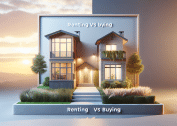Curious about entering the housing market? Discover how affordable homeownership is possible for more people than ever before. This guide explores practical strategies, financing options, first-time buyer programs, and sustainable housing trends—all woven into a straightforward overview to help clarify your path toward a place to call your own.
Understanding Affordable Homeownership
Affordable homeownership can seem like a distant dream, especially with rising property prices and limited inventory. Yet, thoughtful planning and up-to-date information can make this goal more attainable for many households. Across the country, community-based initiatives and national policies are working to bridge the affordability gap, making homeownership a reality for a wider audience. Factors like median income, mortgage requirements, and local incentives play a crucial role in shaping options for prospective homeowners. As cities evolve, they’re increasingly offering pathways that reduce financial strain on buyers.
Rising demand, limited new construction, and shifts in rental versus ownership dynamics fuel conversations about affordability. For many, concerns over monthly payments, down payment requirements, and hidden costs can lead to hesitation. The good news is that many lenders, nonprofits, and government programs offer creative solutions to help first-time buyers make confident decisions. Exploring these resources opens up new possibilities, whether through housing cooperatives, shared equity models, or low down payment mortgage products designed to reduce upfront hurdles.
Understanding the fundamentals of property listings and price trends in a chosen region helps in setting realistic expectations. Considerations like cost per square foot, location, and projected community growth will play into your overall buying experience. In many cases, buyers find that a little research goes a long way in identifying affordable housing markets and available assistance. It’s all about matching your needs, budget, and timing with the best opportunities present on the market.
Exploring First-Time Buyer Assistance Programs
Many first-time homebuyer programs exist to help overcome steep down payments and credit requirements. These initiatives, supported by municipalities and federal agencies, strive to open doors to those who have never owned property before or haven’t in several years. Some programs offer grants, while others provide forgivable loans, closing cost assistance, or reduced mortgage insurance premiums. Seeking out state or city-specific programs can offer unique advantages, such as below-market interest rates or deferred payment options, helping to ease the transition into homeownership (Source: HUD).
Eligibility for these programs usually considers factors such as income, purchase price, and intended occupancy. Educational courses are sometimes required to ensure buyers feel confident about the process and their rights. Completing these courses can unlock extra incentives, like cash back at closing or access to specialized down payment grants. Each program operates with distinct guidelines, so comparing requirements and benefits is important. Asking local lenders about partnerships with nonprofit organizations can uncover additional assistance opportunities that otherwise might be missed.
Applying for and securing support from a first-time buyer program can speed up the purchase timeline and improve loan approval odds. Even modest grants reduce the burden of saving for years, making it easier to jump into the market. Many buyers report increased satisfaction and decreased anxiety when they can tap into clear steps and knowledgeable support. This empowerment is crucial as buyers navigate potential hurdles like limited inventory or competitive bidding situations. The bottom line: every bit of help counts when it comes to making affordable homeownership possible.
Innovative Financing Options and Mortgage Structures
Financing is often seen as the biggest hurdle for aspiring homeowners. Luckily, mortgage products have diversified in recent years to include options like FHA loans, VA loans for veterans, and USDA loans for rural property seekers. These non-traditional loans often require much lower down payments than conventional mortgages, with government backing enhancing approval prospects for those who might otherwise struggle with credit or income thresholds. Exploring fixed versus adjustable-rate mortgages, as well as the advantages of points, can yield long-term savings.
Shared equity mortgages and interest rate buy-down programs are innovative financing models that help make ownership more accessible. In shared equity agreements, a third party (often the government or a nonprofit organization) helps fund the purchase in exchange for a proportionate share of future appreciation. This structure lowers barriers to entry and can foster a stronger sense of community resilience while maintaining financial flexibility for buyers. Considering all available options is key to finding a tailored solution that matches your personal finances and risk tolerance (Source: CFPB).
Understanding how lenders assess risk and determine eligibility can demystify the financing process. Improving your credit score, managing debt-to-income ratios, and prequalifying for loans are common steps recommended by expert advisors. Government-sponsored entities sometimes provide additional guidance for special groups, such as first responders or educators. Overall, a transparent and flexible lending environment increases affordability and encourages more people to pursue homeownership.
Navigating the Search for Affordable Housing
The process of searching for affordable housing can feel overwhelming, but having a strategy helps. Start by narrowing down preferred neighborhoods, taking into account commute times, schools, public transportation, and local amenities. Leveraging online real estate platforms allows you to filter for properties within your price range and desired home features. Partnering with local real estate agents familiar with both the national market and regional trends can yield well-matched leads and valuable insight (Source: National Association of Realtors).
Many areas offer community-based housing initiatives or land trusts that provide below-market housing, especially for families, seniors, and those with limited income. Some community organizations manage waiting lists, while others offer newly built units for sale through lotteries or application-based processes. Staying persistent and informed is important, as openings can occur quickly and require immediate action. Regularly checking municipal housing department websites and subscribing to local community newsletters ensures you stay up to date.
Assessing long-term value is just as important as securing an affordable upfront price. Look for neighborhoods poised for sustainable growth, where future development and infrastructure investment may increase home value over time. Balance price, location, and property condition to choose a home that will suit evolving needs and add stability to lifestyle plans. Ultimately, being informed and realistic about what’s available increases confidence when making an offer.
Considering Hidden Costs and Long-Term Affordability
Beyond the initial purchase price, several hidden costs shape the true affordability of homeownership. Expenses like property taxes, homeowner’s insurance, utility bills, maintenance, and repairs can add up quickly. Many buyers overlook homeowners association (HOA) fees or special assessments in multifamily or planned neighborhoods. Anticipating these factors makes budgeting more accurate and reduces unpleasant surprises after moving in. Many experts suggest creating a maintenance fund and factoring in small upgrades to keep the property in good condition (Source: Urban Institute).
Taking energy efficiency into account can lead to considerable long-term savings. Newer homes may feature modern insulation, efficient appliances, and renewable energy sources that reduce monthly utility costs. For older properties, prioritizing affordable home improvements—like upgrading windows, adding smart thermostats, or weatherproofing—can boost both comfort and resale value. Some municipalities even offer rebates or low-interest financing to help offset these green investments, increasing affordability throughout the homeownership journey.
Careful attention to required maintenance helps preserve property value. Budgeting for annual repairs, upgrades, and unexpected emergencies prevents future financial strain and maintains the home’s appeal. In researching and anticipating these costs early, homeowners protect their investment and make wise decisions about renovations or refinancing. Financial wellness in housing is a dynamic, ongoing process reliant on good planning.
Sustainable and Inclusive Housing Trends
As cities adapt to modern challenges, new housing models are emerging that prioritize sustainability and inclusiveness. These include energy-efficient homes, compact living environments, and co-housing communities designed for interaction. Such models meet the needs of diverse populations while reducing the ecological impact of residential development. Embracing these trends can help buyers find options tailored to both budget and values, providing long-term satisfaction and lower costs (Source: Architectural Record).
Innovative public-private partnerships and nonprofit organizations are actively increasing the supply of affordable homes. Mixed-income communities blend market-rate and subsidized units, fostering greater opportunity and social mobility. These efforts also promote neighborhood diversity, discourage displacement, and help close the affordability gap. Prospective buyers interested in socially conscious housing often find grant-backed pilot projects or newly launched co-living developments that address these shared concerns.
Staying informed about zoning changes and urban planning projects can reveal new affordable housing opportunities. Many municipalities are redefining zoning codes to allow accessory dwelling units (ADUs), increased density, or modular construction—all of which support flexible, sustainable housing. As these trends gain traction, their impact on affordability and choice is set to expand, creating more pathways to ownership for future generations.
References
1. U.S. Department of Housing and Urban Development. (n.d.). Programs of HUD. Retrieved from https://www.hud.gov/program_offices/housing/sfh/buying/
2. Consumer Financial Protection Bureau. (n.d.). What are shared equity mortgages? Retrieved from https://www.consumerfinance.gov/ask-cfpb/what-are-shared-equity-mortgages-en-2079/
3. National Association of Realtors. (n.d.). Quick Real Estate Statistics. Retrieved from https://www.nar.realtor/research-and-statistics/quick-real-estate-statistics
4. Urban Institute. (n.d.). Buying a Home: What Costs Do You Need to Factor In? Retrieved from https://www.urban.org/urban-wire/buying-home-what-costs-do-you-need-factor
5. Architectural Record. (n.d.). The Evolving Definition of Affordable Housing. Retrieved from https://www.architecturalrecord.com/articles/15363-the-evolving-definition-of-affordable-housing
6. Federal Housing Finance Agency. (n.d.). Mortgage Assistance for Homebuyers. Retrieved from https://www.fhfa.gov/Homeownersbuyer/Mortgage-Assistance









